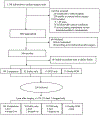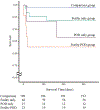Surviving and Thriving 1 Year After Cardiac Surgery: Frailty and Delirium Matter
- PMID: 32949611
- PMCID: PMC7965789
- DOI: 10.1016/j.athoracsur.2020.07.015
Surviving and Thriving 1 Year After Cardiac Surgery: Frailty and Delirium Matter
Abstract
Background: We compared 1-year functional outcomes for 4 cardiac surgery patient groups: comparison (without preoperative frailty or postoperative delirium [POD]), frailty only (with preoperative frailty only), POD only (with POD only), and frailty-POD (combined frailty and POD).
Methods: Consecutive cardiac surgery patients (n = 298) at a university hospital were assessed for preoperative frailty using Fried's phenotype, and POD was assessed daily for 10 days after surgery using the Confusion Assessment Method. Functional outcomes (Barthel Index for activities of daily living [ADL]) and all-cause mortality were evaluated 1-year after surgery.
Results: Preoperative frailty presented in 85 of participants (28.5%) and POD in 38 (12.8%). Frail participants were at increased risk for POD (odds ratio = 4.9; P < .001). Overall, 1-year mortality was 4.0% (n = 12) and functional change was 0.4 ± 11.0 Barthel points. Controlling for age, cardiac risk, and baseline ADL, frailty-only and comparison participants had comparable 1-year functional outcomes. The POD-only group had greater mortality (adjusted hazard ratio = 23.9; P = .01), whereas the combined frailty-POD group had the greatest ADL decline (β = -23.7; P = .01) and the highest mortality (adjusted hazard ratio = 30.2; P = .006) compared with the comparison group.
Conclusions: Preoperative frailty alone did not negatively affect cardiac surgery patients' functional outcomes up to 1 year, but coexisting frailty and POD led to substantial loss of independence on 3 to 4 ADLs and a 30.2-fold higher likelihood of dying 1 year after surgery. Because frailty led to a 4.9-fold increase in POD risk, frailty may serve as a presurgical screen to identify patients who would likely benefit from delirium prevention and functional recovery programs to maximize 1-year postsurgical outcomes.
Copyright © 2021. Published by Elsevier Inc.
Figures
Similar articles
-
The effect of delirium on the association between frailty and postoperative major complications in elderly patients: a mediation analysis.J Anesth. 2025 Apr;39(2):282-291. doi: 10.1007/s00540-025-03460-7. Epub 2025 Feb 25. J Anesth. 2025. PMID: 39998621
-
Assessment of preoperative frailty and identification of patients at risk for postoperative delirium in cardiac intensive care units: a prospective observational study.Eur J Cardiovasc Nurs. 2021 Nov 28;20(8):745-751. doi: 10.1093/eurjcn/zvab076. Eur J Cardiovasc Nurs. 2021. PMID: 34472606
-
Functional Outcomes of Frail Patients After Cardiac Surgery: An Observational Study.Anesth Analg. 2020 Jun;130(6):1534-1544. doi: 10.1213/ANE.0000000000004786. Anesth Analg. 2020. PMID: 32384343 Free PMC article. Clinical Trial.
-
The Association of Preoperative Frailty and Postoperative Delirium: A Meta-analysis.Anesth Analg. 2021 Aug 1;133(2):314-323. doi: 10.1213/ANE.0000000000005609. Anesth Analg. 2021. PMID: 34257192 Free PMC article.
-
Depression as a predictor of postoperative delirium after cardiac surgery: a systematic review and meta-analysis.Interact Cardiovasc Thorac Surg. 2021 Apr 8;32(3):371-379. doi: 10.1093/icvts/ivaa277. Interact Cardiovasc Thorac Surg. 2021. PMID: 33831217 Free PMC article.
Cited by
-
Susceptibility to acute cognitive dysfunction in aged mice is underpinned by reduced white matter integrity and microgliosis.Commun Biol. 2024 Jan 16;7(1):105. doi: 10.1038/s42003-023-05662-9. Commun Biol. 2024. PMID: 38228820 Free PMC article.
-
Association of Postoperative Delirium With Incident Dementia and Graft Outcomes Among Kidney Transplant Recipients.Transplantation. 2024 Feb 1;108(2):530-538. doi: 10.1097/TP.0000000000004779. Epub 2023 Aug 29. Transplantation. 2024. PMID: 37643030 Free PMC article.
-
Knowledge mapping of frailty and surgery: a bibliometric and visualized analysis.Langenbecks Arch Surg. 2024 Sep 27;409(1):290. doi: 10.1007/s00423-024-03477-8. Langenbecks Arch Surg. 2024. PMID: 39331205 Free PMC article.
-
Impact of frailty and prefrailty on the mid-term outcomes and rehabilitation course after cardiac surgery.Surg Today. 2024 Aug;54(8):882-891. doi: 10.1007/s00595-024-02807-z. Epub 2024 Mar 4. Surg Today. 2024. PMID: 38436719 Free PMC article.
-
Neuroprotective effect of remote ischemic preconditioning in patients undergoing cardiac surgery: A randomized controlled trial.Front Cardiovasc Med. 2022 Sep 6;9:952033. doi: 10.3389/fcvm.2022.952033. eCollection 2022. Front Cardiovasc Med. 2022. PMID: 36148077 Free PMC article.
References
-
- Ad N, Holmes SD, Halpin L, Shuman DJ, Miller CE, Lamont D. The effects of frailty in patients undergoing elective cardiac surgery. J Card Sur 2016;31:187–194. - PubMed
-
- Li HC, Chen YS, Chiu MJ, et al. Delirium, subsyndromal delirium, and cognitive changes in individuals undergoing elective coronary artery bypass graft surgery. J Cardiovasc Nurs 2015;30:340–345. - PubMed
-
- Nguyen Q, Uminski K, Hiebert BM, et al. Midterm outcomes after postoperative delirium on cognition and mood in patients after cardiac surgery. J Thorac Cardiovasc Surg 2018;155: 660–667. - PubMed
Publication types
MeSH terms
Grants and funding
LinkOut - more resources
Full Text Sources
Medical



